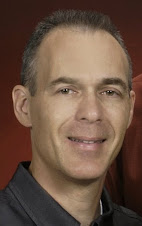I learned at the ribbon cutting that original discussions about a pedestrian overpass in this vicinity began as long ago as 25 years. I also learned that the "all in" costs, including engineering, design, etc. for the bridge was about $8 million, which is a lot more than what I reported in the original post (which may have just been construction costs; I don't know). I also met Penny Gross, the local politician who was instrumental in maintaining pressure on the county to get this bridge completed.
I had a conversation with the Pedestrian Program Manager for Fairfax County and pointed out some of the improvements I thought would make the facility more useful. He was very interested in hearing my point of view and seemed genuinely interested in improving pedestrian experience in Fairfax.
One key improvement that is needed is improving how pedestrians get from the bridge to the stores.
 Here are two photos:
Here are two photos: the first is the sidewalk if you take the stairs and the second is the sidewalk if you take the ramp. Both just end abruptly with the Starbucks and B&N beckoning across the lot.
the first is the sidewalk if you take the stairs and the second is the sidewalk if you take the ramp. Both just end abruptly with the Starbucks and B&N beckoning across the lot.Despite the fact that this area is quite unfriendly to pedestrians, it actually has a lot of pedestrian use. Here are the statistics I gathered on two different dates: Thursday, May 21 from 10:05 to 11:05 AM and Tuesday, June 16 from 1:30 to 2:30 PM. Both days were excellent weather with temps in the 70's.
 (Caveats about these data are at the end of the post)
(Caveats about these data are at the end of the post)In both cases there were more users at the Patrick Henry crossing than on the bridge itself, underscoring the continuing need to make that intersection safe and pleasant for pedestrians. I was surprised that no cyclists used the bridge. It may be that it is still early and they may not be aware. It will be interesting to follow up a year from now.
I also learned from the Pedestrian Program Manager that the county has plans to add signals and crosswalks at Seven Corners itself, which would be a definite improvement to the worn footpaths and crossing-fingers-that-the-light-is-red situation that exists there now.
The people who made the "Mad Dash" across Route 50 did so in three locations: 6 of them crossed between the bridge and Seven Corners; 2 crossed between the bridge and Patrick Henry and 2 crossed 50 yards or so east of Patrick Henry.
The bridge will, of course, require maintenance, and hopefully the county has budgeted for that. Already the bridge has become a magnet for graffiti; I took some photos.



I also noted this overflowing trash receptacle. Over time, if the facility is allowed to become run down, some people will choose not to use it any more. After only a month, this one seems to already be neglected.

During my May 21 data gathering hour, I had conversations with a few bridge users:
- A gentleman carrying a batch of Starbucks coffee (presumably for himself and coworkers) who said he lives in the area. Was skeptical while it was being built but now he really likes it. Admitted to making the mad dash on many occasions, but said he won't need to anymore.
- A mother walking with a young child going to story hour at Barnes and Noble. Used to cross at Seven Corners but now thinks the bridge is a much better option. Never dashed in the past.
- Long-time resident was aware of the numerous pedestrian deaths at this location. Generally pleased with the bridge. Declined to comment when I asked if he had made the mad dash in the past.
- A gentleman from outside the area who had parked in the nearby lot and was just checking the bridge out for curiosity's sake.
===================
Caveats on table data:
Data was gathered while sitting on the bridge. Accuracy as follows:
Bridge users: 100% accurate
PH Drive: Likely undercounted by 10-20% due to distance and sight line. Better data on second date due to learning curve.
Seven Corners: Likely undercounted by a lot due to sightline and inability to see parts of the crossing area
Mad Dash: 100% accurate; no way anyone could cross without being seen.





